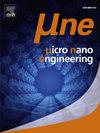利用蛾眼结构对亲水和疏水区域进行图图化制备的水滴排列膜
IF 3.1
Q2 ENGINEERING, ELECTRICAL & ELECTRONIC
引用次数: 0
摘要
随着时间的推移,生物体自然地发展出各种生理特性。例如,玫瑰花瓣对水滴表现出球形的排斥,即使在倒转的情况下也不会掉下来。在我们之前的研究中,我们通过在疏水纳米结构薄膜中创建微孔来重现这种粘合疏水性。然而,这种微观结构引起光散射,降低了薄膜的透过率。为了解决这个问题,我们把注意力集中在一种叫做拟黄甲虫的昆虫上,它利用由疏水表面背景上的亲水区域组成的两区结构从雾中收集水。在之前的研究中,我们将这种结构与蛾眼结构结合在一起,制造了具有高渗透性的粘性疏水表面。我们假设,通过减少两区结构中亲水区域的大小,可以使水滴在亲水区域内对齐。在未来的研究中,我们的目标是利用这些薄膜作为移液器,通过将排列在亲水性区域上的水滴转移到基板上。薄膜的光学透光率很重要,因为它从薄膜的背面水滴被转移的地方进行调整。在本实验中,我们使用光刻技术在蛾眼模具上制备亲水区域,并应用亲水光刻胶。随后,采用UV纳米压印光刻技术,利用疏水抗蚀剂形成双区域蛾眼结构表面。当亲水区域直径在100 μm ~ 750 μm范围内时,加湿器雾化后水滴优先排列在亲水区域上。值得注意的是,即使薄膜倒过来,水滴仍然粘附在一起,并且由于薄膜的透光率为~ 90%,从反面可以看到它们。7 μL水滴在膜上的接触角为148.4度,具有较强的粘接疏水性。本文章由计算机程序翻译,如有差异,请以英文原文为准。

Water droplet alignment film fabricated by patterning hydrophilic and hydrophobic regions using a moth-eye structure
Organisms naturally develop various physiological properties over time. For example, rose petals exhibit spherical repellence to water droplets, preventing them from falling even when inverted. In our previous study, we reproduced this adhesive hydrophobicity by creating microholes in a hydrophobic nanostructured film. However, this microstructure caused light scattering, which reduced the transmittance of the film. To address this, we focused our attention on an insect called the tenebrionid beetle, which collects water from fog using a two-region structure consisting of hydrophilic regions on a hydrophobic surface background. In a previous study, we combined this structure with a moth-eye structure to fabricate an adhesive hydrophobic surface with high permeability. We hypothesized that by reducing the size of the hydrophilic region within the two-region structure, it would be possible to align the water droplets within the hydrophilic regions. In future study, we aim to use these films as pipettes by transferring water droplets aligned on the hydrophilic regions onto a substrate. The optical transmittance of the film is important because it adjusts from the back of the film where the water droplets are being transferred. In this experiment, we fabricated hydrophilic regions using photolithography on a moth-eye mold, applying a hydrophilic photoresist. Subsequently, UV nanoimprint lithography was employed, utilizing a hydrophobic resist to form a two-region moth-eye-structured surface. When the hydrophilic regions had diameters ranging from 100 μm to 750 μm, water droplets preferentially aligned on the hydrophilic regions upon mist exposure using a humidifier. Notably, even when the film is inverted, the water droplets remain adhered, and due to the transmittance of the film of ∼90 %, they are visible from the reverse side. In addition, a 7 μL water droplet placed on the film demonstrated a contact angle of 148.4 degrees, confirming strong adhesive hydrophobicity.
求助全文
通过发布文献求助,成功后即可免费获取论文全文。
去求助
来源期刊

Micro and Nano Engineering
Engineering-Electrical and Electronic Engineering
CiteScore
3.30
自引率
0.00%
发文量
67
审稿时长
80 days
 求助内容:
求助内容: 应助结果提醒方式:
应助结果提醒方式:


